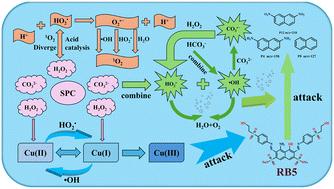Reactive black 5 elimination via a Cu(ii)-induced sodium percarbonate process: Box–Behnken design, mechanism profiling, application performance and energy boosting†
IF 4.2
3区 化学
Q2 CHEMISTRY, PHYSICAL
引用次数: 0
Abstract
The utilization of sodium percarbonate (SPC, Na2CO3·1.5H2O2) as an alternative to H2O2 for degrading recalcitrant organics in advanced oxidation is emerging due to SPC's stability, safety, and pH adaptability. This study innovatively employed Cu(ii)-activated SPC to remove reactive black 5 (RB5), focusing on Box–Behnken design (BBD), mechanism profiling, application performance, and energy boosting. BBD and response surface methodology optimized conditions (2.592 mM Cu(ii), 0.022 mM SPC, pH 7.18) achieved 90.08% RB5 removal (R2 = 0.9997, prediction error <1%), with the model showing strong predictive capability. Quenching experiments and liquid chromatography–mass spectrometry (LC–MS) revealed that 1O2, O2˙−, and CO3˙− were the main active species in oxidizing RB5 through three possible pathways. Cl−, SO42−, NO3−, and HCO3− (0.1–5.0 mM) contained in the ultrapure water did not inhibit RB5 removal in the Cu(ii)/SPC system, and the Cu(ii)/SPC could remove 76.1% of RB5 in industrial wastewater, demonstrating the potential for practical application of this system. The application of energy (heating, ultraviolet light, ultrasound) significantly improved the effectiveness of the Cu(ii)/SPC system in degrading RB5, thus these means can be used to assist in the activation of SPC in real dye wastewater treatment. This work provides theoretical and practical insights for SPC-based advanced oxidation processes.

Cu(ii)诱导过碳酸钠工艺消除活性黑5:Box-Behnken设计、机理分析、应用性能和能量提升
由于过碳酸钠(SPC, Na2CO3·1.5H2O2)的稳定性、安全性和pH适应性,在深度氧化中使用过碳酸钠(SPC, Na2CO3·1.5H2O2)作为H2O2的替代品来降解难降解有机物正在兴起。本研究创新性地采用Cu(II)活化的SPC去除活性黑5 (RB5),重点关注Box-Behnken设计(BBD)、机理分析、应用性能和能量提升。BBD和响应面法优化条件(2.592 mM Cu(II), 0.022 mM SPC, pH 7.18)对RB5去除率为90.08% (R2 = 0.9997,预测误差为1%),模型具有较强的预测能力。猝灭实验和液相色谱-质谱(LC-MS)分析表明,氧化RB5的主要活性物质为1O2、O2˙−和CO3˙−。超纯水中的Cl−、SO42−、NO3−和HCO3−(0.1 ~ 5.0 mM)对Cu(II)/SPC系统对RB5的去除率没有抑制作用,Cu(II)/SPC系统对工业废水中RB5的去除率达到76.1%,具有实际应用价值。能量(加热、紫外光、超声波)的应用显著提高了Cu(II)/SPC体系降解RB5的效果,因此这些手段可用于辅助SPC在实际染料废水处理中的活化。这项工作为基于spc的高级氧化工艺提供了理论和实践见解。
本文章由计算机程序翻译,如有差异,请以英文原文为准。
求助全文
约1分钟内获得全文
求助全文
来源期刊

Catalysis Science & Technology
CHEMISTRY, PHYSICAL-
CiteScore
8.70
自引率
6.00%
发文量
587
审稿时长
1.5 months
期刊介绍:
A multidisciplinary journal focusing on cutting edge research across all fundamental science and technological aspects of catalysis.
Editor-in-chief: Bert Weckhuysen
Impact factor: 5.0
Time to first decision (peer reviewed only): 31 days
 求助内容:
求助内容: 应助结果提醒方式:
应助结果提醒方式:


